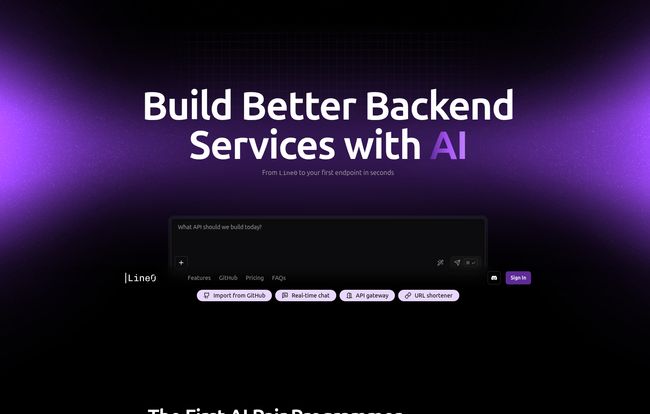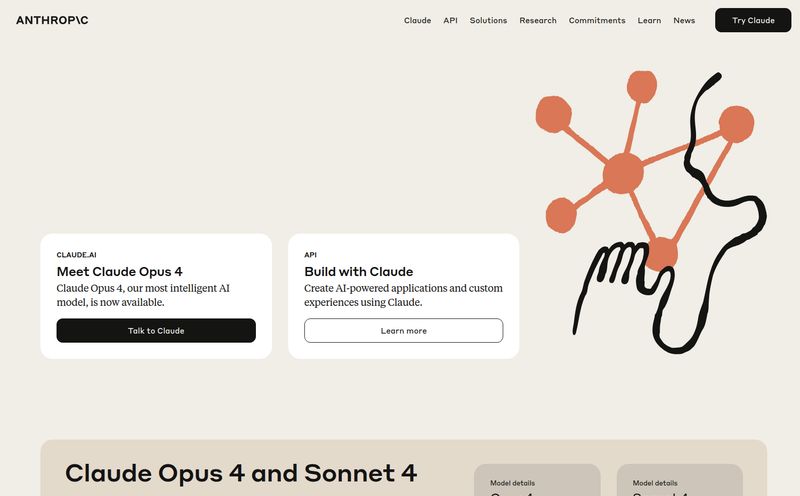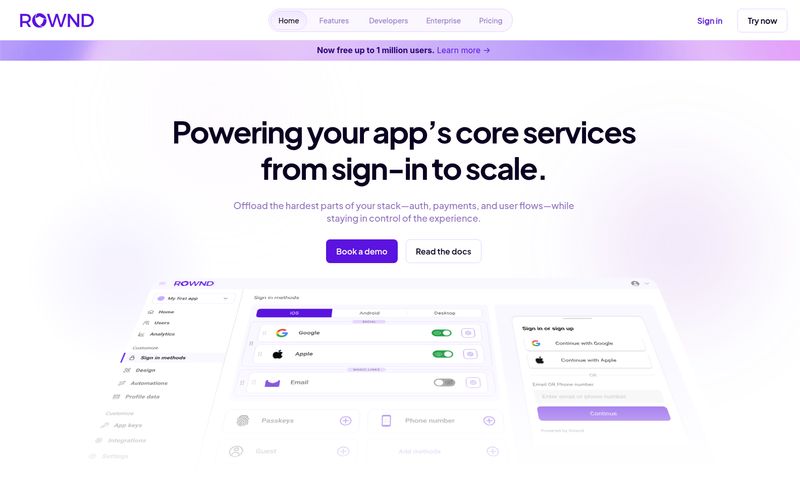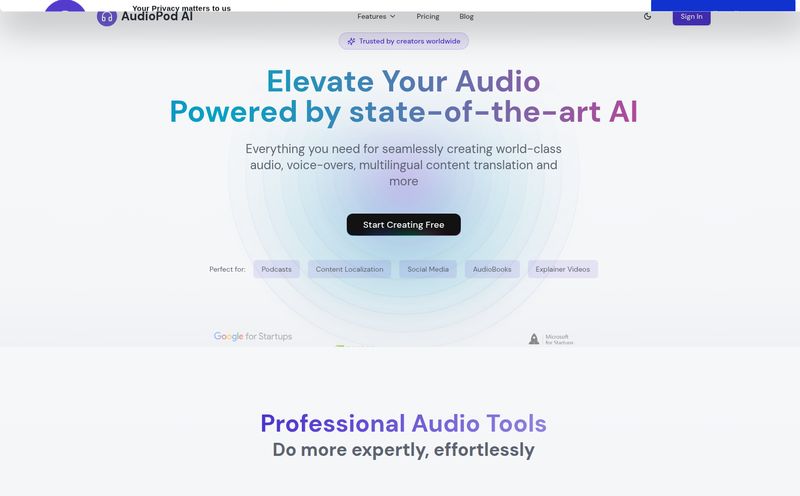How many times have you sat down to start a new project, full of creative fire, only to spend the next two hours wrestling with boilerplate? You know the drill. Setting up the Express server, installing the same ten dependencies, creating the `routes`, `controllers`, and `models` folders, configuring CORS... It's a creative momentum killer. I've been there more times than I can count, and frankly, I'm over it.
The world is absolutely swimming in AI coding assistants right now. They're in every IDE, every text editor, and they're great for autocompleting a function or suggesting a regex pattern you can never remember. But most of them are generalists. They're a swiss army knife. Line0 is different. It's not a knife; it's a scalpel, designed for one specific, often painful, operation: building a backend.
So, What is Line0, Really?
At its core, Line0 is an AI pair programmer that specializes in backend development. Right now, its entire world revolves around Node.js and Express.js, which is a big chunk of the web development pie, so that makes sense as a starting point. Instead of just helping you write code line-by-line, it aims to generate an entire, functional, production-ready service based on your descriptions. Think of it less like a backseat driver suggesting turns, and more like a GPS that builds the car for you before you start the trip. A bold claim, I know. But after playing with it, it's not as far-fetched as it sounds.
You essentially have a conversation with the AI. You tell it, “I need a route to handle user registration,” and it doesn’t just spit out a function. It generates the route file, the controller logic, maybe even a basic data validation structure, all while following common best practices. This is its secret sauce.
The Features That Actually Matter
Tools like this live or die by their features and workflow. It's easy to make a flashy demo, but does it actually save time? In Line0's case, a few things really stood out to me.
More Than Just Prompts: A Natural Language Interface
This is the main event. You're not just getting code snippets. You're describing functionality in plain English. For example, I prompted it to create a simple blog API. I asked for endpoints to create, read, update, and delete posts. It scaffolded the whole thing, creating separate, organized files. It even added comments to the code. The “Just-Tab-to-prompt” feature feels intuitive, making the conversation flow without constantly moving your hands off the keyboard. It feels like directing a very fast, very obedient junior developer.
The GitHub Integration is a Game-Changer
Okay, this is huge. A lot of online code generators leave you with a .zip file and a “good luck!” message. That's not a professional workflow. Line0 has a robust 2-way sync with GitHub. You can import an existing project or start a new one and have it all pushed directly to a repo. As you make changes and generate new features in Line0, you can sync them back. This provides an incredible peace of mind. Your code isn't trapped on some platform; it lives where all your other code lives. This, for me, elevates it from a toy to a serious tool.

Visit Line0
Keeping Things Tidy with Contextual Chats
Have you ever been deep in a conversation with a generic AI chatbot, and it just completely forgets what you were talking about three messages ago? It's infuriating. Line0 attempts to solve this by letting you split features into separate chats. You can have one chat for handling user authentication and a completely different one for managing product inventory. This keeps the AI focused and prevents context bleed. It's a simple idea, but it makes a massive difference in practice.
The 'Coming Soon' Elephant in the Room
Now, let's talk about what's not there yet. The landing page proudly displays a “Built-in API Client” and “Live DB Preview,” both tagged with the dreaded “Coming Soon” label. And man, do I want those features. The idea of building an endpoint and then testing it right there in the same browser tab, with hot-reloads and a live look at my database, is the holy grail of backend development speed. That would be a complete, end-to-end development loop.
For now, you still need to pull the code down and run it locally, and fire up Postman or Insomnia to test your endpoints. It's not a dealbreaker, but it's a gap in the workflow that you can feel. Once these features land, Line0 could become unstoppable for rapid prototyping and MVP development.
So, What's the Catch? A Realistic Look
No tool is perfect, especially not a new one. The most obvious limitation is its current focus on Express.js. If you're a Pythonista working with Django, a Rubyist on Rails, or a Go developer, this isn't for you. Not yet, anyway. The team says more frameworks and languages are on the roadmap, which is promising.
The other thing is the message limits. Every plan, including the paid ones, has a cap on the number of messages you can send per month. For a small project, the 150 messages on the Plus plan are probably fine. But if you’re a power user building something complex, you might find yourself eyeing teh Pro plan's 2000-message limit. It's a necessary evil of running expensive AI models, but it's something to be aware of.
Breaking Down the Line0 Pricing
The pricing structure is pretty straightforward and follows a familiar SaaS model. It’s broken down into three main tiers.
| Plan | Price (Billed Annually) | Key Features |
|---|---|---|
| Free | $0 /month | Good for trying it out. Daily message limits, 10 public projects, uses smaller AI models. |
| Plus | $17 /month | The sweet spot. 150 messages/month, unlimited private projects, most powerful models, and you can opt out of your code being used for training. |
| Pro | $170 /month | For power users and small teams. 2000 messages/month, priority access during busy times, and email support. |
The Free plan is genuinely useful for getting a feel for the platform. The Plus plan at $17/month (annually) feels like a great deal for freelancers, indie devs, or anyone who regularly builds backend services. The ability to opt-out of model training on this tier is a huge win for privacy and commercial projects. The jump to the Pro plan is significant, but for a small agency or a startup where development speed is money, that $170/month could easily pay for itself in a single project.
Who Is Line0 Actually For?
After using it, I have a pretty clear picture of who gets the most out of Line0 right now.
- Frontend Developers: Need a quick, solid backend for your new React or Vue project without getting lost in the weeds? This is your new best friend.
- Indie Hackers & Startups: Your goal is to get a minimum viable product to market yesterday. Line0 can shave weeks off your development timeline.
- Backend Developers: Yes, even us. It demolishes the tedious setup and boilerplate, letting you jump straight into writing the complex business logic that actually matters.
Who is it not for? Probably large enterprise teams with deeply entrenched, custom frameworks and complex deployment pipelines. It's just not built for that kind of environment... yet.
My Final Thoughts: Is Line0 the Future?
I don't think Line0 is going to put backend developers out of a job. Let's just get that out of the way. What it is going to do is change what that job looks like. It's a force multiplier. It takes the most repetitive, time-consuming parts of the role and automates them, freeing up developers to focus on architecture, security, and high-level problem-solving.
It's a powerful, focused tool that knows exactly what it wants to be. Once the built-in testing and DB preview features arrive, it's going to be an absolute powerhouse. For now, it's a ridiculously fast way to get a well-structured Express.js project off the ground and into a GitHub repo. And for many of us, that's more than half the battle.
Frequently Asked Questions
- Do I own the code that Line0 generates?
- Yes, absolutely. According to their FAQ, you own all the code it generates for you. You can use it in personal or commercial projects without issue.
- Is it only for Express.js right now?
- Correct. As of late 2023, its expertise is focused on Node.js and the Express.js framework. They have stated that support for other backend languages and frameworks is on their future roadmap.
- Can Line0 deploy my API services for me?
- No. Line0 is a development tool that helps you write and structure your backend code. You are still responsible for deploying that code to a hosting provider like Vercel, AWS, Heroku, or DigitalOcean.
- How is this different from GitHub Copilot?
- They solve different problems. GitHub Copilot is an AI assistant that lives inside your code editor, suggesting code completions line-by-line. Line0 is a platform that generates entire project structures and feature files based on conversational prompts, outside your local editor.
- Is Line0 actually free to use?
- Yes, there is a free tier that is great for getting started. It has daily message limits and uses their smaller AI models, but it's very functional for small tests and projects.
Conclusion
We're entering an era of specialized AI tools, and Line0 is an exciting example of that trend. By focusing solely on the backend, it provides a level of depth and utility that more generalized tools can't match. It's not perfect, and its full potential is still on the horizon, but what's here today is already impressive. If you work with Node.js and Express, you owe it to yourself to give the free plan a spin. You might just save yourself a few hours on your next project.
Reference and Sources
- Line0 Official Website
- Express.js Official Documentation
- Forbes Article on AI in Software Development



